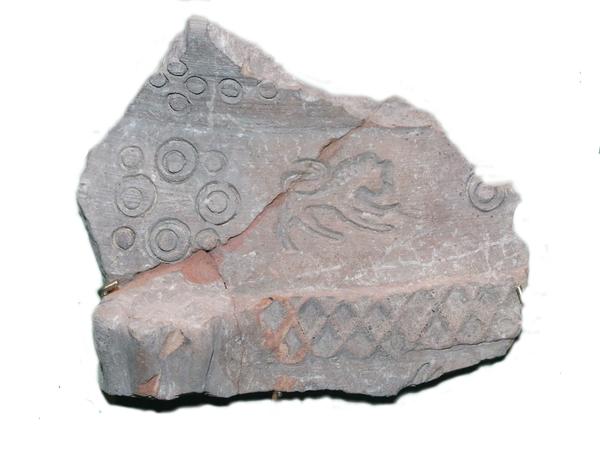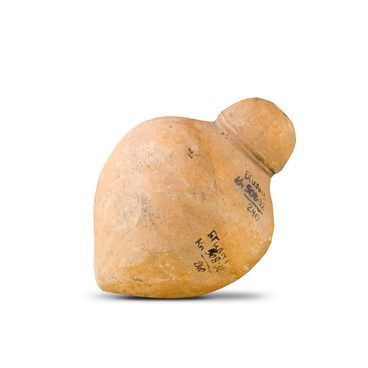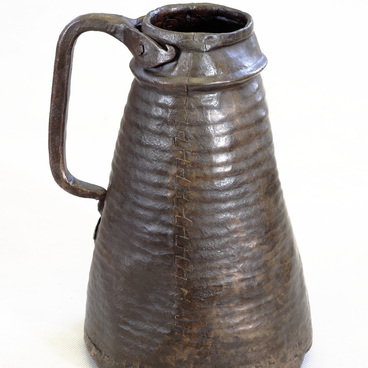During excavations in the Bolgar settlements, archaeologists find two types of ceramics: moulded and pottery. Molded ceramics are dishes handmade from a piece of clay.
This technology emerged 5 thousand years ago; it existed in Volga Bulgaria and in the pre-Mongolian period. Pottery technology —the technology with the use of a pottery wheel, began to develop after the Golden Horde conquered this medieval state.
There were glazed and non-glazed products both in molded and pottery ceramics. The glazing is the procedure when masters polish the vessel to obtain the high lustre, using some smooth item — stone, polishing bone, steel spoon, glass bottle.
During the glazing the clay upper layer became dense; the vessel itself became moisture permeable. The lustre after such a process was intensified after the ceramic item firing.
Bulgars used different types of clays: ochre, red, light gray, and even black. The vessel, the fragment of which is presented at the exposition, probably was made of gray clay using the pottery wheel.
On this fragment, you can see the image of a snow leopard in addition to the net-shaped and circle pattern. This animal was considered sacred among the Bulgars and neighboring tribes in Altai. They were usually depicted as horned; in the nomadic tribes' culture, horns are a sign of uniqueness. The snow leopards represented wealth, strength, authority among the Bolgars. This word was often added to male Tatar names, emphasizing the strength of their owners: Aybars, Bai-bars, Ilbars, Yanbars (‘Bars’ is translated as the ‘snow leopard’). About 20 such names are found among the Tatars today.
Scientists found ceramic fragments with a one-horned walking snow leopard during excavations at a Bolgar ancient settlement back in the 19th century. Judging by archaeological and numismatic materials, the walking one-horned snow leopard was the state emblem of Volga Bulgaria: the image of this animal was applied to coins, trade stamps, and seals. You can find records about Bulgaria coat of arms in the Old Russian chronicles: ‘There is a Bulgarian stamp with a walking snow leopard depicted.’ Neighboring tribes called Volga Bulgaria and its people by the name of this animal: ‘bars ile’ or ‘barsil’. The snow leopard is also shown on the modern Tatarstan Republic coat of arms, but unlike its historical predecessor, it is depicted not with a horn, but with wings.
This technology emerged 5 thousand years ago; it existed in Volga Bulgaria and in the pre-Mongolian period. Pottery technology —the technology with the use of a pottery wheel, began to develop after the Golden Horde conquered this medieval state.
There were glazed and non-glazed products both in molded and pottery ceramics. The glazing is the procedure when masters polish the vessel to obtain the high lustre, using some smooth item — stone, polishing bone, steel spoon, glass bottle.
During the glazing the clay upper layer became dense; the vessel itself became moisture permeable. The lustre after such a process was intensified after the ceramic item firing.
Bulgars used different types of clays: ochre, red, light gray, and even black. The vessel, the fragment of which is presented at the exposition, probably was made of gray clay using the pottery wheel.
On this fragment, you can see the image of a snow leopard in addition to the net-shaped and circle pattern. This animal was considered sacred among the Bulgars and neighboring tribes in Altai. They were usually depicted as horned; in the nomadic tribes' culture, horns are a sign of uniqueness. The snow leopards represented wealth, strength, authority among the Bolgars. This word was often added to male Tatar names, emphasizing the strength of their owners: Aybars, Bai-bars, Ilbars, Yanbars (‘Bars’ is translated as the ‘snow leopard’). About 20 such names are found among the Tatars today.
Scientists found ceramic fragments with a one-horned walking snow leopard during excavations at a Bolgar ancient settlement back in the 19th century. Judging by archaeological and numismatic materials, the walking one-horned snow leopard was the state emblem of Volga Bulgaria: the image of this animal was applied to coins, trade stamps, and seals. You can find records about Bulgaria coat of arms in the Old Russian chronicles: ‘There is a Bulgarian stamp with a walking snow leopard depicted.’ Neighboring tribes called Volga Bulgaria and its people by the name of this animal: ‘bars ile’ or ‘barsil’. The snow leopard is also shown on the modern Tatarstan Republic coat of arms, but unlike its historical predecessor, it is depicted not with a horn, but with wings.



